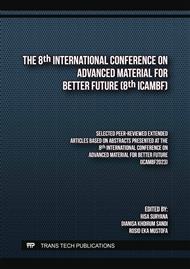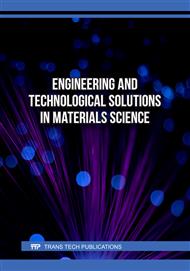[1]
S. Roy and S. Ragunath, "Emerging membrane technologies for water and energy sustainability: Future prospects, constraints and challenges," Energies, vol. 11, no. 11, p.2997 %@ 1996-1073, 2018.
DOI: 10.3390/en11112997
Google Scholar
[2]
E. Obotey Ezugbe and S. Rathilal, "Membrane technologies in wastewater treatment: a review," Membranes, vol. 10, no. 5, p.89 %@ 2077-0375, 2020.
DOI: 10.3390/membranes10050089
Google Scholar
[3]
N. Shehata et al., "Membrane-based water and wastewater treatment technologies: Issues, current trends, challenges, and role in achieving sustainable development goals, and circular economy," Chemosphere, vol. 320, p.137993, 2023/04/01/ 2023.
DOI: 10.1016/j.chemosphere.2023.137993
Google Scholar
[4]
M. Elma, R. A. Ghani, A. Rahma, A. D. Alyanti, and N. Dony, "Banana Peels Pectin Templated Silica Ultrafiltration Membrane in Disk Plate Configuration Applied for Wetland Water Treatment," Journal of Advanced Research in Fluid Mechanics and Thermal Sciences, vol. 100, no. 1, pp.77-88, 2022.
DOI: 10.37934/arfmts.100.1.7788
Google Scholar
[5]
H.-H. Chang, S.-C. Chen, D.-J. Lin, and L.-P. Cheng, "Preparation of bi-continuous Nylon-66 porous membranes by coagulation of incipient dopes in soft non-solvent baths," Desalination, vol. 313, pp.77-86, 2013/03/15/ 2013.
DOI: 10.1016/j.desal.2012.12.009
Google Scholar
[6]
W. Z. A. W. Jusoh, S. A. Rahman, A. L. Ahmad, and N. M. Mokhtar, "Fabrication and characterisation of a polyamide thin-film composite membrane on a nylon 6,6 substrate for isopropanol dehydration," Comptes Rendus Chimie, vol. 22, no. 11, pp.755-760, 2019/11/01/ 2019.
DOI: 10.1016/j.crci.2019.08.001
Google Scholar
[7]
P. Poletto, J. Duarte, M. B. Thürmer, V. d. Santos, and M. Zeni, "Characterization of Polyamide 66 membranes prepared by phase inversion using formic acid and hydrochloric acid such as solvents," Materials Research, vol. 14, 2011.
DOI: 10.1590/s1516-14392011005000087
Google Scholar
[8]
E. Mahmoudi, L. Y. Ng, W. L. Ang, Y. T. Chung, R. Rohani, and A. W. Mohammad, "Enhancing Morphology and Separation Performance of Polyamide 6,6 Membranes By Minimal Incorporation of Silver Decorated Graphene Oxide Nanoparticles," Scientific Reports, vol. 9, no. 1, p.1216, 2019/02/04 2019.
DOI: 10.1038/s41598-018-38060-x
Google Scholar
[9]
P. Poletto, J. Duarte, M. B. Thürmer, and M. Zeni, "Polyamide 66 membranes with PVP addition prepared by phase inversion," Desalination and Water Treatment, vol. 27, no. 1-3, pp.76-80, 2011/03/01 2011.
DOI: 10.5004/dwt.2011.2055
Google Scholar
[10]
M. Elma et al., "The Effect Of Banana Pectin Concentration On Silica Membrane Performance For Brackish Water," Jukung Jurnal Teknik Lingkungan, vol. 5, no. 2, pp.45-51, 2019.
Google Scholar
[11]
M. Elma, A. Pratiwi, A. Rahma, E. L. A. Rampun, and N. Handayani, "The Performance of Membranes Interlayer-Free Silica-Pectin Templated for Seawater Desalination via Pervaporation Operated at High Temperature of Feed Solution," Materials Science Forum, vol. 981, pp.349-355, 03/01 2020.
DOI: 10.4028/www.scientific.net/msf.981.349
Google Scholar
[12]
M. Elma et al., "Development of Hybrid and Templated Silica-P123 Membranes for Brackish Water Desalination," Polymers, vol. 12, no. 11, p.2644, 2020.
DOI: 10.3390/polym12112644
Google Scholar
[13]
M. Elma, N. Kadek Devi Ananda Saraswati, P. Fransiska Afrida Simatupang, R. Febriyanti, A. Rahma, and F. Ria Mustalifah, "Hydrogel derived from water hyacinth and pectin from banana peel as a membrane layer," Materials Today: Proceedings, vol. 87, pp.13-17, 2023/01/01/ 2023.
DOI: 10.1016/j.matpr.2023.01.368
Google Scholar
[14]
M. Elma, R. A. Ghani, A. Rahma, A. D. Alyanti, N. J. J. o. A. R. i. F. M. Dony, and T. Sciences, "Banana peels pectin templated silica ultrafiltration membrane in disk plate configuration applied for wetland water treatment," vol. 100, no. 1, pp.77-88, 2022.
DOI: 10.37934/arfmts.100.1.7788
Google Scholar
[15]
M. Elma, F. R. Mustalifah, L. Suryani, E. L. A. Rampun, A. J. N. s. Rahma, and t. proceedings, "Wetland saline water and acid mine drainage desalination by interlayefree silica pectin membrane from banan peels," pp.271-279, 2020.
DOI: 10.11594/nstp.2020.0543
Google Scholar
[16]
M. Elma, A. E. Pratiwi, A. Rahma, E. L. A. Rampun, and N. Handayani, "The performance of membranes interlayer-free silica-pectin templated for seawater desalination via pervaporation operated at high temperature of feed solution," in Materials Science Forum, 2020, vol. 981, pp.349-355: Trans Tech Publ.
DOI: 10.4028/www.scientific.net/msf.981.349
Google Scholar
[17]
M. Elma, A. Rahma, U. Kusumawati, R. S. K. Pratama, A. D. J. J. o. A. R. i. F. M. Alyanti, and T. Sciences, "Single vs multichannel silica-pectin ultrafiltration membranes for treatment of natural peat water," vol. 100, no. 2, pp.33-46, 2022.
DOI: 10.37934/arfmts.100.2.3346
Google Scholar
[18]
F. Mustalifah, A. Rahma, and M. Elma, "Chemical cleaning to evaluate the performance of silica-pectin membrane on acid mine drainage desalination," in IOP Conference Series: Materials Science and Engineering, 2021, vol. 1195, no. 1, p.012057: IOP Publishing.
DOI: 10.1088/1757-899x/1195/1/012057
Google Scholar
[19]
A. E. Pratiwi, M. Elma, M. D. Putra, A. Mirwan, A. Rahma, and E. L. A. Rampun, "Innovation of carbon from pectin templated in fabrication of interlayer-free silica-pectin membrane," 2019.
DOI: 10.14710/jksa.22.3.93-98
Google Scholar
[20]
A. E. Pratiwi, M. Elma, A. Rahma, E. L. Rampun, and G. S. J. M. T. Saputro, "Deconvolution of pectin carbonised template silica thin-film: synthesis and characterisation," vol. 2019, no. 9, pp.5-8, 2019.
DOI: 10.1016/s0958-2118(19)30167-3
Google Scholar
[21]
A. Rahma, M. Elma, E. L. Rampun, S. L. Sintungkir, and M. F. J. M. T. Hidayat, "Effect of backwashing process on the performance of an interlayer-free silica–pectin membrane applied to wetland saline water pervaporation," vol. 2022, no. 2, 2022.
DOI: 10.12968/s0958-2118(22)70019-5
Google Scholar
[22]
E. L. Rampun, M. Elma, A. Rahma, and A. E. J. M. T. Pratiwi, "Interlayer-free silica–pectin membrane for sea-water desalination," vol. 2019, no. 12, pp.5-9, 2019.
DOI: 10.1016/s0958-2118(19)30222-8
Google Scholar
[23]
C.-W. Hsieh, B.-X. Li, and S.-Y. Suen, "Alicyclic polyimide/sio2 mixed matrix membranes for water/n-butanol pervaporation," Membranes, vol. 11, no. 8, p.564 %@ 2077-0375, 2021.
DOI: 10.3390/membranes11080564
Google Scholar
[24]
B. Hastuti, F. Totiana, and R. Winiasih, "The Role of Pectin in Pb Binding by Carrot Peel Biosorbents: Isoterm Adsorption Study," Iop Conference Series Materials Science and Engineering, 2018.
DOI: 10.1088/1757-899x/349/1/012011
Google Scholar
[25]
M. I. A. Abdel Maksoud, A. S. Awed, R. Sokary, and M. Bekhit, "Effect of gamma irradiation on the free-standing polyvinyl alcohol/chitosan/Ag nanocomposite films: insights on the structure, optical, and dispersion properties," Applied Physics A, vol. 127, pp.1-11 %@ 0947-8396, 2021.
DOI: 10.1007/s00339-021-04776-3
Google Scholar
[26]
T. Balint, B. P. Chang, A. K. Mohanty, and M. Misra, "Underutilized agricultural co-product as a sustainable biofiller for polyamide 6, 6: Effect of carbonization temperature," Molecules, vol. 25, no. 6, p.1455 %@ 1420-3049, 2020.
DOI: 10.3390/molecules25061455
Google Scholar
[27]
M. Mehrabanian and M. Nasr-Esfahani, "HA/nylon 6, 6 porous scaffolds fabricated by salt-leaching/solvent casting technique: effect of nano-sized filler content on scaffold properties," International journal of nanomedicine, pp.1651-1659 %@ 1176-9114, 2011.
DOI: 10.2147/ijn.s21203
Google Scholar
[28]
N. Cheval, N. Gindy, C. Flowkes, and A. Fahmi, "Polyamide 66 microspheres metallised with in situ synthesised gold nanoparticles for a catalytic application," Nanoscale Research Letters, vol. 7, pp.1-9, 2012.
DOI: 10.1186/1556-276x-7-182
Google Scholar
[29]
N. K. E. M. Khori, Salmiati, T. Hadibarata, and Z. Yusop, "A Combination of Waste Biomass Activated Carbon and Nylon Nanofiber for Removal of Triclosan from Aqueous Solutions," J. Environ. Treat. Tech., vol. 8, no. 3, pp.1036-1045, 2020.
DOI: 10.47277/jett-8(3)1
Google Scholar
[30]
J. C. Farias-Aguilar, M. J. Ramírez-Moreno, L. Téllez-Jurado, and H. Balmori-Ramírez, "Low pressure and low temperature synthesis of polyamide-6 (PA6) using Na0 as catalyst," Materials Letters, vol. 136, pp.388-392 %@ 0167-577X, 2014.
DOI: 10.1016/j.matlet.2014.08.071
Google Scholar
[31]
V. M. K. Ndesendo et al., "In vivo evaluation of a mucoadhesive polymeric caplet for intravaginal anti-HIV-1 delivery and development of a molecular mechanistic model for thermochemical characterization," Drug development and industrial pharmacy, vol. 41, no. 8, pp.1274-1287 %@ 0363-9045, 2015.
DOI: 10.3109/03639045.2014.947506
Google Scholar
[32]
F. S. Forouz, S. A. H. Ravandi, and A. R. Allafchian, "Removal of Ag and Cr Heavy Metals Using Nanofiber Membranes Functionalized with Aminopropyltriethoxysilane (APTES)," Current Nanoscience, vol. 12, pp.266-274, 2016.
DOI: 10.2174/1573413712999151216162920
Google Scholar
[33]
Ş. Parlayıcı, A. Avcı, and E. Pehlivan, "Electrospinning of polymeric nanofiber (nylon 6, 6/graphene oxide) for removal of Cr (VI): synthesis and adsorption studies," Journal of Analytical Science and Technology, vol. 10, pp.1-13, 2019.
DOI: 10.1186/s40543-019-0173-5
Google Scholar
[34]
J. Yan et al., "Graphene Oxide Modified Polyamide 66 Ultrafiltration Membranes with Enhanced Anti-Fouling Performance," Membranes, vol. 12, 2022.
DOI: 10.3390/membranes12050458
Google Scholar
[35]
F. S. Silitonga, "Fabrication of Complex Polyelectrolyte Membrane of Chitosan-Pectin Crosslinked as Bioadsorbent," Journal of Chemical Natural Resources, vol. 1, no. 2, pp.52-59 %@ 2656-1492, 2019.
DOI: 10.32734/jcnar.v1i2.1253
Google Scholar
[36]
P. H. Chen et al., "Novel Chitosan-Pectin Composite Membranes with Enhanced Strength, Hydrophility and Controllable Disintegration," Carbohydrate Polymers, vol. 82, pp.1236-1242, 2010.
DOI: 10.1016/j.carbpol.2010.06.057
Google Scholar



